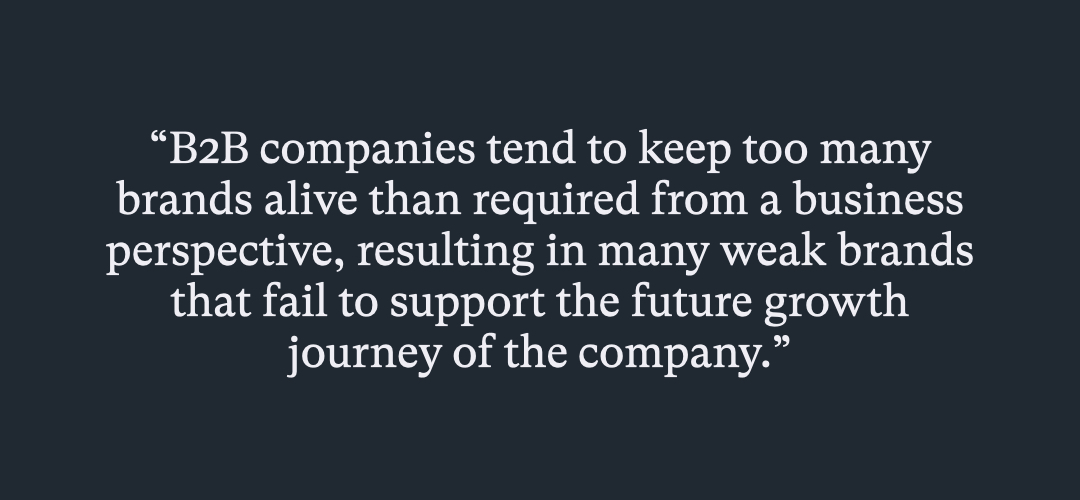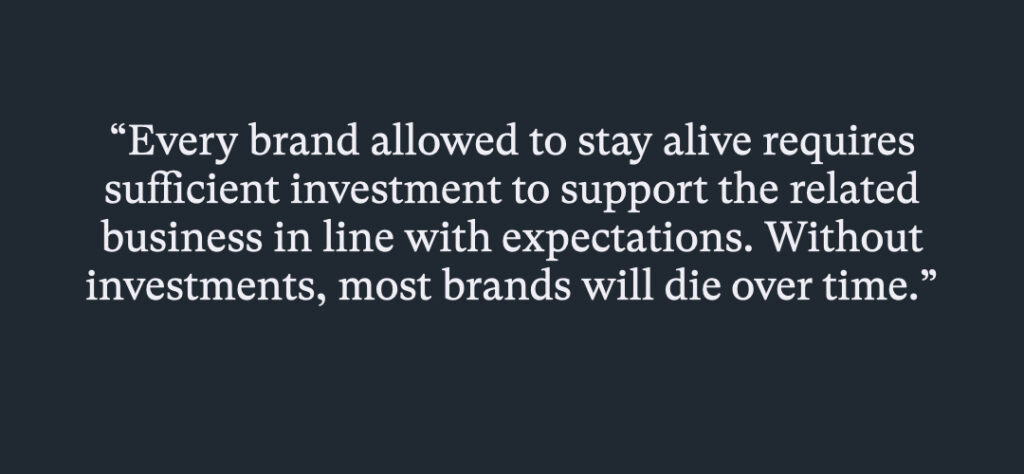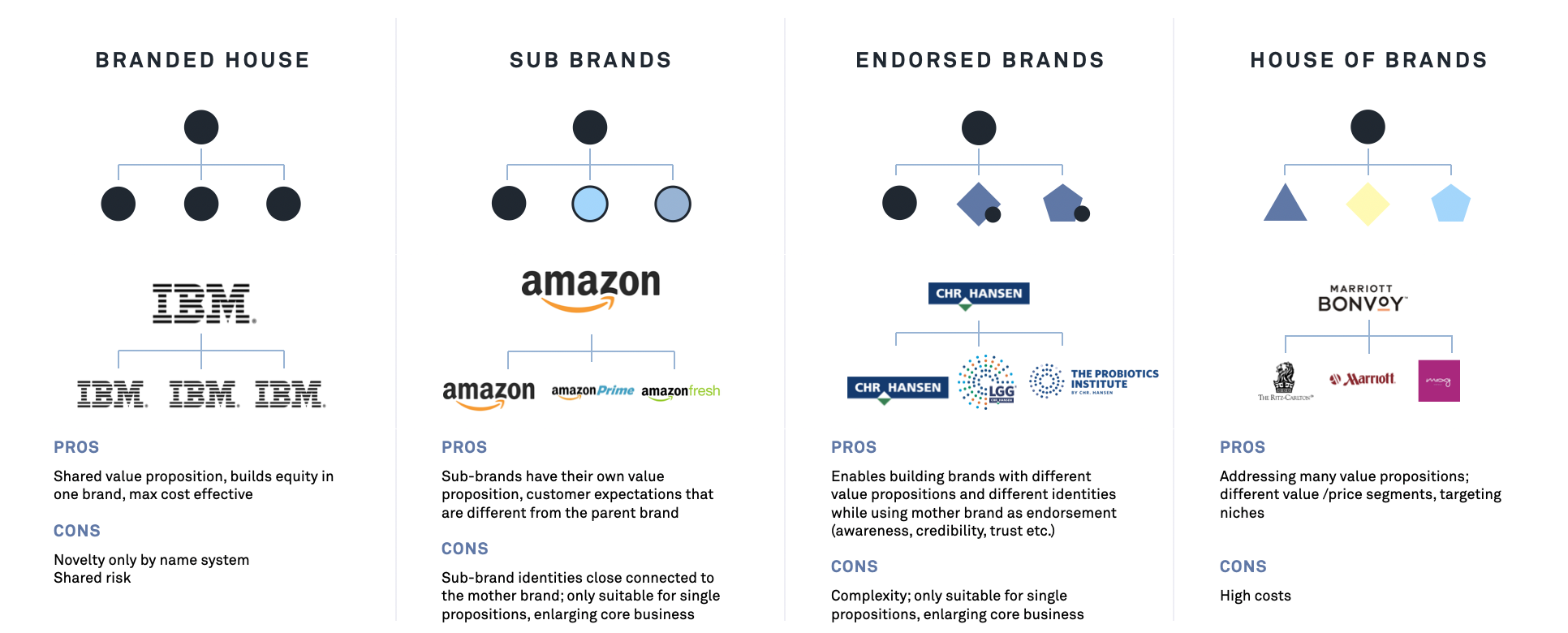Organic and inorganic growth can lead to an increasing number of brand assets, logos and trademarks under the corporate brand. Individually, there is often a good reason for them all to exist. This could be commercial opportunities, new product developments, a new segment, a new market, an acquired company with existing brand awareness, or the like. But from an outside perspective, some brand “collections” add confusion and unnecessary costs rather than clarity and commercial performance.
We operate in a world where growth is often still seen as the ultimate sign of success for B2B businesses. The management we meet when working with B2B clients are usually exceptional minds who may have built their companies from scratch with hard work, passion, and dedication. They know everything about evaluating market opportunities and growing their offerings. For them, it is all about business.
However, what often is lacking is an understanding that branding the business is part of building the business. Scaling from a local player to an international company requires a strong brand with a good reputation, and a relevant value proposition, in the minds of customers, investors and future employees. Surprisingly, the branding perspective repeatedly is not represented in the top management. Short-term, this is not a problem at all. However, long-term, B2B companies tend to keep too many brands alive than required from a business perspective, resulting in many weak brands that fail to support the future growth journey of the company. Therefore, we recommend critically evaluating all existing brands regularly, their relation to each other and their relevance for driving the core business.

M&A-based growth
While the equity of the acquired brand is part of the paid acquisition price, a branding perspective does not often play a vital role in the acquisition strategy or the integration process afterwards. Keeping the acquired brand alive just for its existing brand awareness is a managemental “non-decision”. The question is, instead, whether the acquired brand name, its logo and image are essential for the future development of the core business or not:
- Can we keep key employees from the acquired company if we integrate their brand?
- Can the acquired business flourish under the corporate brand or another already existing brand or not?
- What brand-architecture strategy best supports the overall business strategy in our current market situation?
- If the acquired brand is rated as essential now, is that a long-term perspective or the best solution for a transition period?

Every brand allowed to stay alive requires sufficient investment to support the related business in line with expectations. Without investments, most brands will die over time. Therefore, the overall perspective is essential, critically investigating how many brands (besides the corporate brand) are needed to grow the core business and how many brands will be supported with sufficient investments before the cost/value ratio becomes imbalanced.
Organic growth
When marketing and sales departments discover new opportunities in the market, the tempting solution is often to launch a new sub or product brand. We all love something new. And yes, it is easier to sell something new than the good old stuff the company has had for the last ten years. And suddenly, the commercial teams start creating new concepts, logos, trademarks, visual expressions, campaigns and thus, new brands.
Of course, there is a truth in the point of view that entering new segments, markets, or categories can require launching a new sub-brand. But it is crucial to analyse the relationship between this new asset and the existing brand portfolio from a long-term perspective with the overall business strategy in mind:
- Does the additional sale justify the additional costs in brand building?
- Has the solution to creating a new logo, brand, brand image a long-term perspective?
- Is there a compelling risk or image issue for the mother brand that justifies launching a different brand?
- How many resources is the management willing to invest in building the new brand long-term?
- Could we obtain the same sales by offering the product/solution under an existing brand?
- Does the new offering require a sub-brand, or is a nominator to the mother brand sufficient?
- Could we develop, broaden and strengthen an existing brand with the new offering?
- Do we have an exit strategy? Are we planning to divest only the business unit built under the new brand, or are we planning to sell the company as a whole?
- Is creating a new brand for this new offering in line with the overall business strategy?
Brand architecture strategy is a management decision
Passionate employees will always have a strong opinion on behalf of their brand. But the question of how to handle brand portfolios needs to be addressed and decided by the top management. The decision needs to be taken from the perspective of the entire business and on how a brand(s) and brand-architecture strategy can best support the core business and the overall business strategy.
Growing today without a brand architecture strategy can limit the growth of tomorrow
Without a brand-architecture strategy in place, growth can result in an overcrowded brand portfolio and increased complexity within the company, which is then equally mirrored by the number of logos, visual (sub)identities, messages, trademarks and marketing staff. Complexity leads to internal discussions, confusion, lost focus, and daily friction.
Keeping several brands alive will multiply costs. Moreover, money will most likely get misallocated if there isn’t a strategic reason for all these investments. Consequently, the key brand(s) lack investments, prohibiting these brands from flourishing and supporting the future growth of the core business.
6 indicators that you might be having a brand architecture challenge – or opportunity (source):
- Missing framework for how to deal with newly acquired brands or for how to launch new brands/products
- Highly staffed marketing department without strategic reasoning
- A cluttered brand portfolio that is confusing to both customers and employees
- Poor cross- or up-sell, or cannibalisation of brands within the existing brand portfolio
- Key brands don’t grow brand equity as required for the development of the core business
- Revenue is growing slowly.
Identity – who are we, and why are customers buying from us?
In our experience, identity work can help companies make better decisions on brand architecture and brand portfolio for their business. Understanding who they are as a company helps them understand which brand is the driving asset for the business. The same goes for managing a brand portfolio. Without a clear understanding of the individual brand identities, you cannot decide on a potential brand stretch or re-organisation of the brand portfolio.
How to define the right brand architecture strategy?
For many companies, it is helpful to start this journey by looking into the Brand Relationship Spectrum, created by Aaker & Jochimsthaler. We recommend starting the discussion with the default architecture strategy, the One-Brand / Branded-House strategy. The One-Brand strategy is the most effective and efficient strategy for building a strong brand, especially in today’s fragmented markets and media landscape. In fact, eight out of ten of the most valuable B2B brands in 2019 followed a One-Brand strategy.

Suppose you wish to deviate from the most efficient brand architecture strategy; in our humble opinion, you need compelling arguments to justify the additional costs that will inevitably follow that decision.
Want to know more?
Related insights
Identity first: The key to lasting strategic impact
Many of us have heard the numbers… 60-70% of all strategies fail. And if we go all the way back…
Aligning the organisation for transformation and growth
After a busy time with exciting projects, we had the opportunity to reflect on one of our customers’ pervasive challenges.…
Crafting company names with an Identity-driven approach
In the dynamic realm of business, a company name is more than a mere identifier – it’s a powerful vessel…
In the pursuit of talent – how identity can help shape and strengthen your employer brand
Research shows that most leaders are facing severe challenges onboarding the right competencies to the company. In addition, many encounter…

